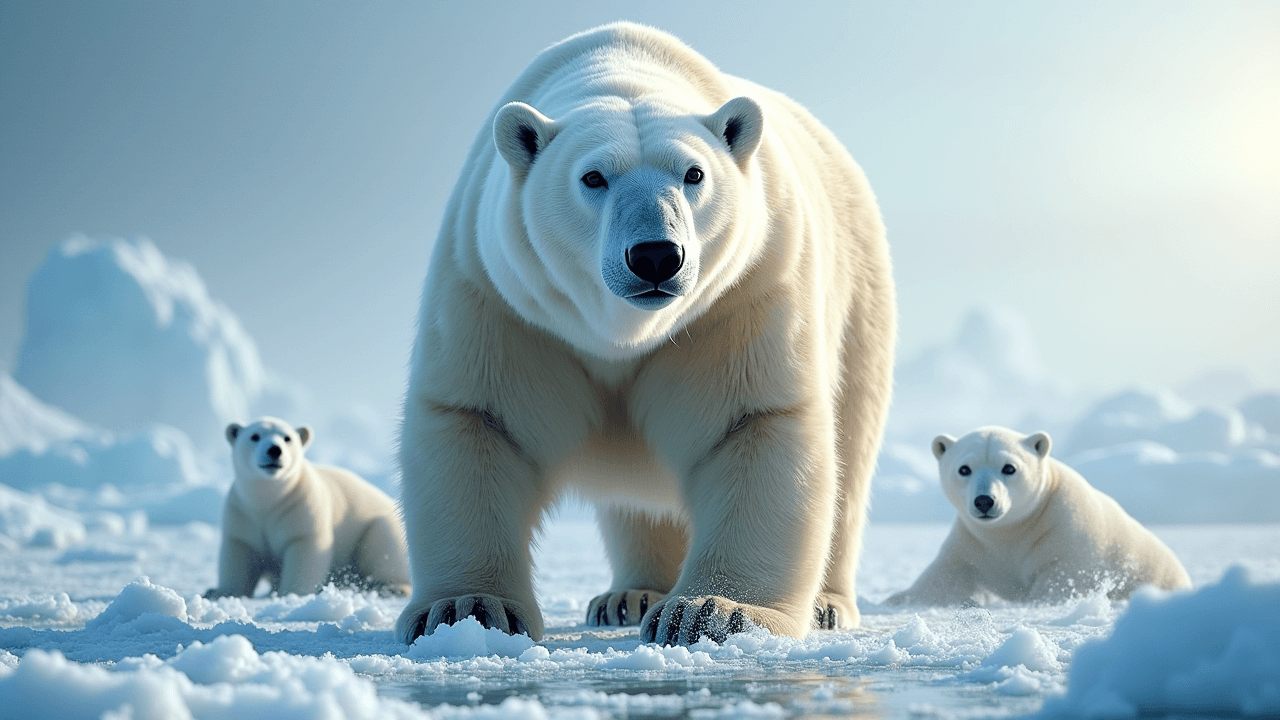All right, buckle up, because today we’re diving into the world of polar bears. Polar Bear sounds fun, yeah, and we’re tackling a question from one of our listeners, and honestly, it’s one that had me stumped for a bit too. Why are polar bears so big?
The Mystery of Polar Bear Size
Hmm? I mean, you’d think in a place like the Arctic being smaller would be way more convenient, right? Less to feed, exactly, easier to hide from predators. You know, makes sense, yeah? So why are these guys big, like tanks?
Well, it’s a really cool question, it is, and it shows how sometimes our gut feeling about nature is totally off. Yeah, we’ve got a bunch of research lined up, and even this super interesting thread someone sent in, oh, cool, yeah, to help us unpack all this and get this the answer links back to geometry.
Understanding the Square-Cube Law
Geometry, okay, now you’re really making me notice. No, no, don’t worry. It’s not that bad. It’s this thing called the square cube law.
Square cube law, okay, that does sound a little intimidating. Not gonna lie, I promise it’s simpler than it sounds. Imagine a cube like a dice. Okay, got it now, if you double the length of all its sides, so it gets bigger, its surface area increases by four times, but the volume inside increases by eight times, really, yeah. So basically, as something gets bigger, its volume grows way faster than its surface area.
So what you’re saying is larger objects have less surface compared to how much space they take up inside?
Exactly. And this little geometric quirk, it affects everything, like how we build buildings to, yep, you guessed it, polar bear biology. Okay, I’m seeing a tiny connection here, but you gotta help me out.
Less Surface Area, Less Heat Loss
All right, less surface area, less heat loss, which, when you’re living in a freezer like the Arctic, is kind of a big deal.
You’re totally on the right track. Imagine a hot cup of coffee, right? A bigger mug with less surface area for its size will stay warm way longer than a smaller one because the heat doesn’t escape as fast.
Exactly. It’s the same deal with animals a polar bear size. It’s like its own personal insulation keeping all that precious body heat trapped inside, even when it’s freezing. Okay, that makes a lot of sense.
Polar Bears and Their Arctic Lifestyle
But hold on. What about food? I mean, finding enough to fuel a massive polar bear in a place where, let’s be honest, there aren’t a ton of snacks lying around that can’t be easy, right, right?
And that’s where things get even more fascinating. You see polar bears, they’re not just big and fluffy, no, they’re actually amazing swimmers. Okay, I have to admit, I always kind of picture them like lumbering around on the ice. Swimming isn’t really the first thing that comes to mind when I think polar bear.
Swimming Skills of Polar Bears
I get it. But that size, you know, the one that helps them stay warm, yeah, it also makes them super buoyant in the water.
Ah, okay, and those big paws, you know, yeah, they’re like natural paddles, who use them to just power through the water. So are we talking like graceful dolphin swimming, or more, like, I don’t know, okay, maybe not. Dolphin graceful, okay. But still, they’ve been tracked swimming hundreds of miles, like crazy, distances or hundreds, really?
Yeah, there was even one study they found a bear that swam over 400 miles, 400 that’s insane, how?
I mean, what’s powering them?
That’s like, it’s all about that size, okay, I’m starting to see the upside of being the big guy now.
Hunting Seals: The Polar Bear’s Favorite Meal
And speaking of size, yeah, think about their favorite meal, seals. Okay. Seal, yeah.
Now seals, they need breathing holes in the ice to, you know, to breathe, right?
Exactly. And those holes, they can be tough to find, especially in a place like the Arctic.
Exactly. But a polar bear, with its size, its swimming skills, it can cover a ton of ground, so it’s like, the bigger their territory, the more chances they have of finding those breathing holes.
Exactly. It’s not just about catching a seal once they find one, right? It’s about finding the seal in the first place. You got it.
It’s about having the like, the reach, the endurance to actually locate those seals in this massive, icy desert. Okay, so size equals warmth, size equals reach, makes sense, but there’s got to be more to it, right?
You’re right. When they do catch a seal all that size, it’s not just about swimming anymore. What else?
It’s about power. They need to be strong enough to pull those seals out of the water, overpower them.
Oh, yeah, I wouldn’t want to get in a fight with a polar bear, you and me both.
So yeah, it’s like this whole package deal. So we’re talking size, warmth, reach, strength. It’s like the ultimate Arctic survival kit.
Bergman’s Rule and Polar Bear Evolution
You know what’s funny, I always thought those big animals in cold places were just, I don’t know, a coincidence, but is there like, a scientific term for that, like, you know, bigger animals in colder climates?
There totally is. It’s called Bergman’s rule.
Bergman’s rule, okay, I’m gonna bust that out at my next party. Yeah, we’re gonna be so impressed, I know, right?
What is Bergman’s Rule?
So Bergman’s rule, what’s the rundown?
So Bergman’s rule, what’s the deal with that?
So basically, it says that with animals, the ones way up north or down south in the cold places, they tend to be bigger than their relatives in warmer spots, like those Siberian tigers, right?
The huge ones, exactly. They’re way bigger than those sleek Sumatran tigers from, you know, the warmer parts.
I’ve always loved those size comparisons. It’s crazy, it’s wild.
And it’s not just tigers, think, moose, wolves, even different penguins. It’s like this pattern all over the animal kingdom, huh?
So it’s like a real thing, not just a coincidence.
Totally. Bergman’s rule is all about observation.
The Science Behind Bergman’s Rule
But the really cool part is, there’s actual science behind it, like biological stuff going on.
Oh, now we’re talking what’s the science say? Spill the beans.
So one theory is all about those, like, limbs and stuff.
You know, larger animals often have shorter legs, tails, even ears.
Makes sense. Less to get cold, I’m with you exactly.
Less surface area, less heat loss, which is key. When it’s freezing your fur off, it makes you appreciate how tough those environments are.
It all comes back to our polar bear question, doesn’t it?
It’s not just about being big. It’s about being big in all the right ways.
Totally. It’s about the square cube law, Bergman’s rule and all those wild adaptations that let polar bears not just survive, but like completely rock it in one of the toughest places on Earth.
It really does make you think about how amazing evolution is, right? Who knew geometry and physics played such a big part in making these cuddly looking but fierce predators.
Nature is full of surprises, that’s for sure.
Imagining a Smaller Polar Bear
And speaking of surprises, I have one last Polar Bear thought for our listeners. Imagine you could shrink a polar bear like way down to the size of a husky, right?
Okay, I’m picturing it.
Could it still hack it in the Arctic? What do you think?
That’s a good one.
It makes you really see how well suited they are to their environment.
I’m gonna say no, all those things we talked about, the warmth, the hunting style wouldn’t really work the same at that size.
Exactly. It goes to show that sometimes bigger is better, especially when you’re a polar bear.
Couldn’t have said it better myself.
This has been awesome. Thanks for diving into the world of polar bears with me, anytime and for everyone listening, keep those questions coming. You never know what other cool creatures we’ll be chatting about next until then. Stay curious. Everyone.
Frequently Asked Questions
Why are polar bears larger in colder climates?
Polar bears are larger in colder climates due to Bergman’s rule, which states that animals in colder environments tend to be bigger to reduce heat loss and increase survival chances.
How does the square-cube law apply to polar bears?
The square-cube law explains that as polar bears increase in size, their volume grows faster than their surface area, resulting in less heat loss and better insulation in cold environments.
What role does a polar bear’s size play in hunting seals?
A polar bear’s large size allows it to cover more territory, swim longer distances, and overpower seals, making it easier to locate and catch prey in the Arctic.
How do polar bears adapt their swimming abilities to their size?
Polar bears use their large paws as natural paddles, which, combined with their buoyancy, enables them to swim long distances efficiently, aiding in their hunting and survival.
What is Bergman’s rule and how does it relate to polar bears?
Bergman’s rule observes that animals in colder regions tend to be larger than their counterparts in warmer areas. This rule explains why polar bears are so large, helping them retain heat and survive in the Arctic.
Your Hosts

Alex & Maria
Join Alex Thompson and Maria Davis as they navigate the fascinating world of knowledge. With their combined expertise and passion for learning, they simplify the complex and make every episode a journey worth taking.

